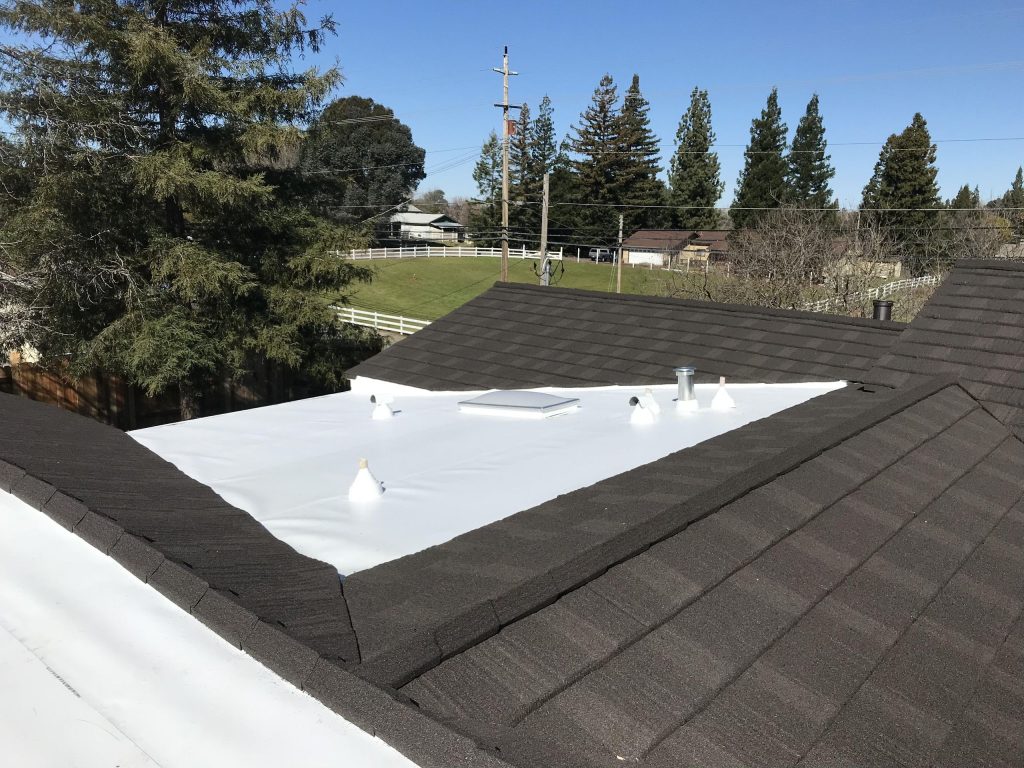TPO roofing is quickly becoming a go-to choice for modern homes and commercial buildings alike, and for good reason.
It’s durable, energy-efficient, and cost-effective, making it a smart option if you want performance without the high price tag.
In this guide, we’ll break down what TPO roofing is, why it’s gaining popularity, and whether it’s the right fit for your property.
What is TPO roofing?
TPO (Thermoplastic Olefin) roofing is a durable, energy-efficient flat roofing material. It’s known for being heat-reflective and resistant to UV damage, making it a popular choice for commercial roofs.
Key Takeaways
- TPO roofing is a single-ply membrane roofing material that offers energy efficiency and durability.
- It is commonly used for flat or low-slope roofs, especially in commercial buildings.
- TPO roofing is relatively easy to install and maintain, making it a cost-effective option for long-term use.
What Is TPO Roofing? A Detailed Overview


TPO stands for Thermoplastic Olefin, a type of single-ply membrane roofing material that is made from a blend of rubber and plastic.
When it comes to roofing materials, there are many options available, each with its own set of benefits.
One popular choice for both residential and commercial buildings is TPO roofing.
If you’re considering this type of roofing for your home or business, it’s essential to understand what TPO is, how it works, and why it might be the right choice for your needs.
In this article, we’ll dive into TPO roofing, its advantages, and what makes it stand out from other materials.
TPO roofing has become a popular option for both residential and commercial properties, particularly for flat or low-slope roofs.
The material is known for its durability, energy efficiency, and ability to withstand extreme weather conditions.
Unlike traditional asphalt roofing or shingles, TPO roofing comes in large rolls that are laid out across the roof surface and sealed together to create a continuous, watertight barrier.
It is highly resistant to tears, punctures, and impact, making it a durable choice for areas with harsh weather
The Benefits of TPO Roofing
TPO roofing offers a number of advantages that make it an attractive option for homeowners and business owners alike. Here are some of the key benefits:
Energy Efficiency
One of the main reasons TPO roofing is so popular is its energy-efficient properties.
TPO roofs are often highly reflective, which means they can reflect a significant amount of the sun’s rays, reducing heat absorption.
This helps to keep buildings cooler in the summer, which can lead to lower cooling costs and improved energy efficiency.
Benefits of Hot Climates
TPO roofing is particularly beneficial in warmer climates, such as areas in California or Florida, where cooling costs can be a significant concern.
Durability and Longevity
TPO roofing is designed to withstand the elements, making it ideal for homes and commercial buildings in regions with harsh weather conditions.
It is resistant to ultraviolet (UV) radiation, ozone, and chemical damage, which helps it last longer compared to other roofing materials.
Tough Against Weather
Whether you’re dealing with the intense heat of Arizona or the heavy rainfall of the Pacific Northwest, TPO roofing provides reliable protection against the elements.
Low Maintenance
TPO roofing requires very little maintenance once it is installed.
The smooth surface of TPO makes it easy to clean and maintain, and it is highly resistant to dirt, algae, and moss growth.
Regular inspections are recommended to ensure that the seams remain intact and to spot any potential issues before they become major problems.
Cost-Effective
With its low maintenance needs, TPO roofing can be a cost-effective choice for property owners in the long term.
Environmentally Friendly
TPO roofing is considered an environmentally friendly option due to its recyclability.
The material can be recycled at the end of its life cycle, reducing the environmental impact compared to non-recyclable materials like asphalt.
Additionally, the reflective surface of TPO helps to reduce the urban heat island effect, contributing to cooler temperatures in cities.
Sustainable Choice
For environmentally-conscious homeowners or businesses, TPO roofing offers a sustainable solution without sacrificing performance.
How Is TPO Roofing Installed?
Installing TPO roofing typically requires professional expertise to ensure the job is done correctly and the roof performs as expected.
The installation process involves the following steps:
Preparing the Roof Surface
Before the TPO membrane is applied, the roof surface must be cleaned and prepared.
This includes removing any debris, repairing any damaged areas, and ensuring the surface is dry and smooth.
In some cases, a layer of insulation may be added to improve energy efficiency.
Applying the Membrane
The TPO membrane comes in large rolls, which are unrolled and spread over the roof.
The edges of the rolls are then sealed together using heat or adhesive to create a continuous barrier. The seams are carefully welded or bonded to ensure there are no gaps or leaks.
Sealing the Edges
The edges of the TPO membrane are secured with flashing to prevent water from getting underneath the material.
Proper sealing at the edges is crucial to the longevity of the roof and to ensure that it remains watertight.
Final Inspection
Once the TPO roofing is installed, a final inspection is performed to ensure that all seams and edges are properly sealed.
The roof is tested for any potential leaks or weaknesses, and any necessary adjustments are made before the project is completed.
TPO Roofing vs. Other Roofing Materials
While TPO roofing offers many benefits, it’s not the only option available. Here’s how TPO compares to other common roofing materials:
TPO vs. PVC Roofing
PVC (Polyvinyl Chloride) is another popular single-ply roofing material that is similar to TPO.
Both offer excellent durability and energy efficiency, but PVC tends to be more expensive than TPO.
PVC roofing is also more resistant to certain chemicals, making it a better choice for industrial applications.
TPO: More affordable, good for residential and commercial buildings, especially in mild climates.
PVC: Higher cost, superior chemical resistance, and better for specific commercial applications.
TPO vs. EPDM Roofing
EPDM (Ethylene Propylene Diene Monomer) roofing is another popular flat roofing option. EPDM is made from rubber and is known for its flexibility and durability.
While EPDM is slightly less expensive than TPO, it does not offer the same energy-efficient properties, and its black surface absorbs heat rather than reflecting it.
TPO: Better for energy efficiency, more reflective surface.
EPDM: More flexible, but less energy-efficient.
TPO vs. Asphalt Roofing
Asphalt roofing is a traditional material commonly used for sloped roofs.
While asphalt is affordable and widely available, it does not offer the same durability, energy efficiency, or ease of maintenance as TPO roofing.
Asphalt is also more prone to damage from UV rays and temperature fluctuations.
TPO: More energy-efficient, durable, and low-maintenance.
Asphalt: More affordable initially, but requires more maintenance and has a shorter lifespan.
When to Consider TPO Roofing
TPO roofing is an excellent choice for a wide range of buildings, but it may not be the best option for every situation.
Here are some factors to consider when deciding if TPO is right for you:
Flat or Low-Slope Roofs
TPO roofing is ideal for flat or low-slope roofs, which are common in both residential and commercial buildings.
If your roof has a steep pitch, you may want to consider other materials better suited for that type of structure.
Energy Efficiency Needs
If you live in an area with high temperatures, such as Florida or Texas, TPO roofing can help reduce cooling costs by reflecting sunlight and reducing heat absorption.
It is also beneficial for commercial buildings that require temperature control.
Budget Considerations
TPO roofing is generally more affordable than alternatives like PVC and offers many of the same benefits.
If you are looking for an energy-efficient roofing solution without breaking the bank, TPO might be a great option.
Frequently Asked Questions (FAQs)
1. Is TPO roofing good for residential homes?
Yes, TPO roofing is an excellent choice for residential homes with flat or low-slope roofs, offering durability, energy efficiency, and low maintenance.
2. How long does TPO roofing last?
TPO roofing can last between 15 to 25 years, depending on the quality of installation, climate, and maintenance.
3. Can I install TPO roofing myself?
While it’s possible to install TPO roofing yourself, it’s best to hire a professional for proper installation and to ensure that the roof is sealed and functioning properly.
Conclusion
TPO roofing offers a range of benefits, including energy efficiency, durability, and easy maintenance, making it a great choice for homes and businesses alike.
Its affordability and effectiveness in reducing energy costs make it especially appealing in warmer climates.
Whether you’re considering TPO for a new build or as a replacement for an old roof, it’s important to understand the material’s advantages, limitations, and suitability for your needs.
When installed correctly, TPO roofing can provide reliable protection for your home or business for many years.


















